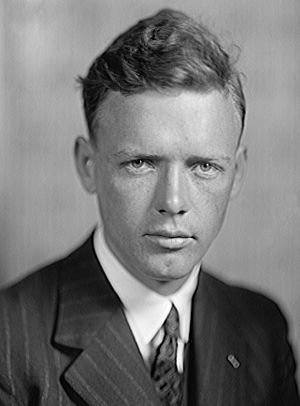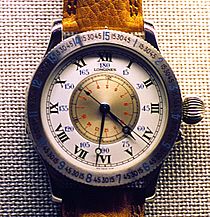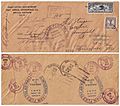Charles Lindbergh facts for kids
Quick facts for kids
Charles Lindbergh
|
|
|---|---|

Photo by Harris & Ewing
|
|
| Born |
Charles Augustus Lindbergh
February 4, 1902 |
| Died | August 26, 1974 (aged 72) Kipahulu, Maui, Hawaii, U.S.
|
| Resting place | Palapala Ho'omau Church, Kipahulu, Maui, Hawaii |
| Nationality | |
| Other names |
|
| Education | Sidwell Friends School Redondo Union High School Little Falls High School University of Wisconsin–Madison (did not graduate) |
| Occupation | Aviator, author, inventor, explorer, activist |
| Known for | First solo transatlantic flight (1927) |
| Home town | Little Falls, Minnesota |
| Spouse(s) | Anne Morrow Lindbergh (1929–1974) (his death) |
| Children | With Anne Morrow Lindbergh: Charles Augustus Lindbergh Jr. Jon Lindbergh Land Morrow Lindbergh Anne Spencer Lindbergh (Perrin) Scott Lindbergh Reeve Lindbergh (Brown) With Brigitte Hesshaimer: Dyrk Hesshaimer Astrid Hesshaimer Bouteuil David Hesshaimer With Marietta Hesshaimer: Vago Hesshaimer Christoph Hesshaimer. With Valeska (surname unknown): a son (name unknown) a daughter (name unknown) |
| Parent(s) | Charles August Lindbergh Evangeline Lodge Land Lindbergh |
| Military career | |
| Allegiance | |
| Service/ |
|
| Years of service | 1925–1941, 1954–1974 |
| Rank | |
| Awards | Medal of Honor (1927) Distinguished Flying Cross (1927) Congressional Gold Medal (1928) |
| Signature |  |
Charles Augustus Lindbergh (February 4, 1902 – August 26, 1974), known as "Lucky Lindy" and "The Lone Eagle", was a pioneering United States airplane pilot. He became famous for making the first solo non-stop flight across the Atlantic Ocean in 1927.
Contents
Early life
Lindbergh was born in Detroit, Michigan. His parents were Swedish immigrants. He grew up in Little Falls, Minnesota. His father, Charles August Lindbergh, was a lawyer and later a U.S. congressman, who was against the United States entering into World War I. His mother was a teacher. While he was young, he was interested in machines. In 1922 he joined a pilot training program with Nebraska Aircraft, bought his own airplane, and became a stunt pilot. In 1924, he started training as a pilot with the United States Army Air Corps.
After finishing first in his class, Lindbergh took his first job as pilot of an airmail route in St. Louis. He flew the mail in an airplane.
In April 1923, while visiting friends in Lake Village, Arkansas, Lindbergh made his first ever flight over Lake Village and Lake Chicot.
First solo flight across the Atlantic Ocean
Lindbergh gained fame around the world as the first pilot to fly solo (alone) and non-stop across the Atlantic Ocean. He flew from Roosevelt Airfield (Nassau County, Long Island), New York, USA to Paris, France on May 20-21, 1927 in his single-engine airplane The Spirit of St. Louis. He needed 33.5 hours for the trip.
On arriving at Paris, Lindbergh "circled the Eiffel Tower" before flying to the airfield. He flew over the crowd at Le Bourget Aerodrome at 10:16 and landed at 10:22 PM on Saturday, May 21, on the far side of the field and "nearly half a mile from the crowd," as reported by The New York Times. The airfield was not marked on his map and Lindbergh knew only that it was some seven miles northeast of the city; he initially mistook it for some large industrial complex because of the bright lights spreading out in all directions—in fact the headlights of tens of thousands of spectators' cars caught in "the largest traffic jam in Paris history" in their attempt to be present for Lindbergh's landing. A crowd estimated at 150,000 stormed the field, dragged Lindbergh out of the cockpit, and carried him around above their heads for "nearly half an hour." When he arrived back in the United States, many warships and aircraft escorted him to Washington, D.C. where President Calvin Coolidge gave him the Distinguished Flying Cross.
Barely two months after Lindbergh arrived in Paris, G. P. Putnam's Sons published his 318-page autobiography "WE", which was the first of 15 books he eventually wrote or to which he made significant contributions.
Time magazine honored Lindbergh as its first Man of the Year in 1928, President Herbert Hoover appointed him to the National Advisory Committee for Aeronautics in 1929, and he received the Congressional Gold Medal in 1930.
Lindbergh's act won him the Orteig Prize, which was 25,000 US dollars. A parade was held for him on 5th Avenue in New York City on June 13, 1927. At the end of the year, he was named Time's first Man of the Year.
He served on a variety of national and international boards and committees, including the central committee of the National Advisory Committee for Aeronautics in the United States.
Family
Lindbergh married Anne Morrow in 1929.
The couple had six children: Charles Augustus Lindbergh Jr. (1930–1932); Jon Morrow Lindbergh (1932–2021); Land Morrow Lindbergh (b. 1937), who studied anthropology at Stanford University and married Susan Miller in San Diego; Anne Lindbergh (1940–1993); Scott Lindbergh (b. 1942); and Reeve Lindbergh (b. 1945), a writer. Lindbergh taught Anne how to fly, and she accompanied and assisted him in much of his exploring and charting of air routes.
Lindbergh saw his children for only a few months a year. He kept track of each child's infractions (including such things as gum-chewing) and insisted that Anne track every penny of household expenses in account books.
Later life
After World War II, Lindbergh lived in Darien, Connecticut, and served as a consultant to the Chief of Staff of the United States Air Force and to Pan American World Airways.
In his later years, he became a Pulitzer Prize-winning author, international explorer and environmentalist, helping to establish national parks in the U.S. and protect certain endangered species and tribal people in both the Philippines and east Africa.
Lindbergh was deeply concerned about the negative impacts of new technologies on the natural world and native peoples. He campaigned to protect endangered species including the humpback whale, blue whale, Philippine eagle, and the tamaraw (a rare dwarf Philippine buffalo).
In an essay appearing in the July 1964 Reader's Digest, Lindbergh wrote about a realization he had in Kenya during a trip to see land being considered for a national park. He contrasted his time amid the African landscape with his involvement in a supersonic transport convention in New York, and while "lying under an acacia tree," he realized how the "construction of an airplane" was simple compared to a bird. He wrote "that if I had to choose, I would rather have birds than airplanes." In this essay, he questioned his old definition of "progress," and concluded that nature displayed more actual progress than humanity's creations. He wrote several more essays for Reader's Digest and Life, urging people to respect the self-awareness that came from contact with nature, which he called the "wisdom of wildness," and not merely follow science. As David Boocker wrote in 2009, Lindbergh's essays, appearing in popular magazines, "introduced millions of people to the conservation cause," and he made an important "appeal to lead a life less complicated by technology."
On May 14, 1971, Lindbergh received the Philippine Order of the Golden Heart at a formal dinner at Malacañang Palace in Manila. He was described as an aviation pioneer who had symbolized the advance of technology, and who now was a symbol of the drive to protect natural life from technology. Lindbergh actively participated in both conservation and advocacy for tribal minorities in the Philippines, frequently visiting the country and working to protect species including the tamaraw and Philippine eagle, which he described as a "magnificent bird," lending his name to a law against killing or trapping the animal.
Lindbergh also joined with early aviation industrialist, former Pan Am executive vice president, and longtime friend, Samuel F. Pryor Jr., in "efforts by the Nature Conservancy to preserve plants and wildlife in Kipahulu Valley" on the Hawaiian island of Maui.
Lindbergh spent his last years on Maui in his small, rustic seaside home. In 1972, he became sick with cancer and ultimately died of lymphoma on the morning of August 26, 1974, at age 72.
Scientific activities
Lindbergh wrote to the Longines watch company and described a watch that would make navigation easier for pilots. First produced in 1931, they called it the "Lindbergh Hour Angle watch", and it remains in production today.
In 1929, Lindbergh became interested in the work of rocket pioneer Robert H. Goddard. By helping Goddard secure an endowment from Daniel Guggenheim in 1930, Lindbergh allowed Goddard to expand his research and development. Throughout his life, Lindbergh remained a key advocate of Goddard's work.
In 1930, Lindbergh's sister-in-law developed a fatal heart condition. Lindbergh began to wonder why hearts could not be repaired with surgery. Starting in early 1931 at the Rockefeller Institute and continuing during his time living in France, Lindbergh studied the perfusion of organs outside the body with Nobel Prize-winning French surgeon Alexis Carrel. Although perfused organs were said to have survived surprisingly well, all showed progressive degenerative changes within a few days. Lindbergh's invention, a glass perfusion pump, named the "Model T" pump, is credited with making future heart surgeries possible. In this early stage, the pump was far from perfected. In 1938, Lindbergh and Carrel described an artificial heart in the book in which they summarized their work, The Culture of Organs, but it was decades before one was built. In later years, Lindbergh's pump was further developed by others, eventually leading to the construction of the first heart-lung machine.
Legacy
Lindbergh is honored in aviation for mapping out polar air-routes, flying at high altitudes, and decreasing fuel use.
Lindbergh's legacy is, in part, his unique solo flight which changed public opinion about the value and significance of aircraft and air travel. In greater part, his legacy developed from what he did with his status and fame. He used his celebrity to advance aviation across the world.
Images for kids
-
The Spirit of St. Louis on display at the National Air and Space Museum
-
Charles and Anne Morrow Lindbergh
-
Lindbergh's grave in Kipahulu, Maui, Hawaii. The epitaph "If I take the wings of the morning, and dwell in the uttermost parts of the sea" is from Psalm 139:9.
-
President Calvin Coolidge presents Lindbergh with a Hubbard Medal, 1928
-
The Congressional Gold Medal presented August 15, 1930, to Lindbergh by President Herbert Hoover
-
Lindbergh's Medal of Honor
See also
 In Spanish: Charles Lindbergh para niños
In Spanish: Charles Lindbergh para niños




























